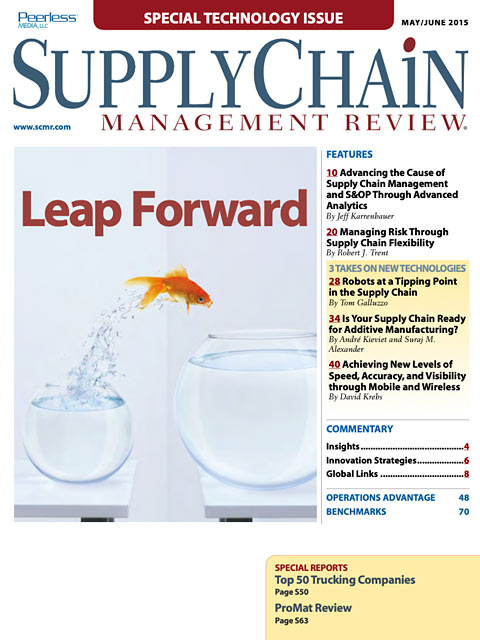Sorry, but your login has failed. Please recheck your login information and resubmit. If your subscription has expired, renew here.
May-June 2015
As supply chain managers we are challenged year in and year out to figure out new, innovative ways to improve our operations. We have to translate educated guesses about what’s next into new investments in our processes. Such may be the case with robotics, 3D printing and additive manufacturing, and investments in new mobile technologies. However, successful planning, including planning for risk, resiliency, and flexibility, can help prepare you for whatever is next. Browse this issue archive.Need Help? Contact customer service 847-559-7581 More options
Cassandra suffered from a special curse: She was the Greek prophetess that no one believed—sometimes to his or her detriment. The same can be true for demand forecasters and the sales and operations planning (S&OP) team when they are planning for, or living through, a downturn that no one else sees coming or believes is possible. As the steadfast harbingers of bad news, their mettle will be tested as pressures are brought to change their forecasts. In order to survive, it’s important for them to remember that they are indeed partners in setting and helping a company meet its corporate financial objectives.*
The brunt of these pressures largely falls upon the demand forecasting organization because demand forecasts drive supply plans. When, like Cassandra, the forecast is for a significant downward change in business, sales and marketing personnel will deny it could happen; finance will panic about operating margins, and executives will have doubts. I know this because I experienced a tough year during my five-year tenure managing the forecasting organization for the field service division of a Fortune 500 computer manufacturer. While assuming the role of Corporate Cassandra was stressful, it was both my best and worst year in forecasting because it was an important developmental year.
This column gives an account of a period that began with the preliminary revenue forecast for the following year’s budgeting process. I use it to discuss lessons learned should forecasters and their S&OP partners experience a similar year that could involve surviving an awkward, unsettling, and politicized environment.
 |
This complete article is available to subscribers
only. Click on Log In Now at the top of this article for full access. Or, Start your PLUS+ subscription for instant access. |
SC
MR
Sorry, but your login has failed. Please recheck your login information and resubmit. If your subscription has expired, renew here.
May-June 2015
As supply chain managers we are challenged year in and year out to figure out new, innovative ways to improve our operations. We have to translate educated guesses about what’s next into new investments in our… Browse this issue archive. Access your online digital edition. Download a PDF file of the May-June 2015 issue. |
Download Article PDF |
Cassandra suffered from a special curse: She was the Greek prophetess that no one believed—sometimes to his or her detriment. The same can be true for demand forecasters and the sales and operations planning (S&OP) team when they are planning for, or living through, a downturn that no one else sees coming or believes is possible. As the steadfast harbingers of bad news, their mettle will be tested as pressures are brought to change their forecasts. In order to survive, it’s important for them to remember that they are indeed partners in setting and helping a company meet its corporate financial objectives.*
The brunt of these pressures largely falls upon the demand forecasting organization because demand forecasts drive supply plans. When, like Cassandra, the forecast is for a significant downward change in business, sales and marketing personnel will deny it could happen; finance will panic about operating margins, and executives will have doubts. I know this because I experienced a tough year during my five-year tenure managing the forecasting organization for the field service division of a Fortune 500 computer manufacturer. While assuming the role of Corporate Cassandra was stressful, it was both my best and worst year in forecasting because it was an important developmental year.
This column gives an account of a period that began with the preliminary revenue forecast for the following year’s budgeting process. I use it to discuss lessons learned should forecasters and their S&OP partners experience a similar year that could involve surviving an awkward, unsettling, and politicized environment.
 |
SUBSCRIBERS: Click here to download PDF of the full article. |
SC
MR

Latest Supply Chain News
- Survey reveals strategies for addressing supply chain, logistics labor shortages
- Israel, Ukraine aid package to increase pressure on aerospace and defense supply chains
- How CPG brands can deliver on supplier diversity promises
- How S&OP provides the answer to in-demand products
- AI, virtual reality is bringing experiential learning into the modern age
- More News
Latest Podcast

 Explore
Explore
Topics
Latest Supply Chain News
- Survey reveals strategies for addressing supply chain, logistics labor shortages
- Israel, Ukraine aid package to increase pressure on aerospace and defense supply chains
- How CPG brands can deliver on supplier diversity promises
- How S&OP provides the answer to in-demand products
- AI, virtual reality is bringing experiential learning into the modern age
- Humanoid robots’ place in an intralogistics smart robot strategy
- More latest news
Latest Resources

Subscribe

Supply Chain Management Review delivers the best industry content.

Editors’ Picks





